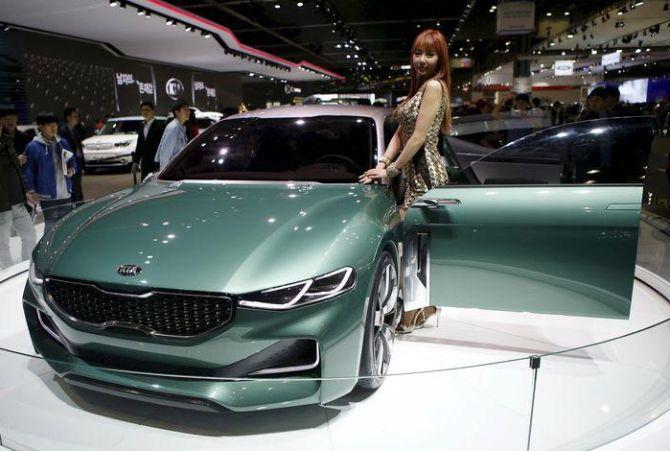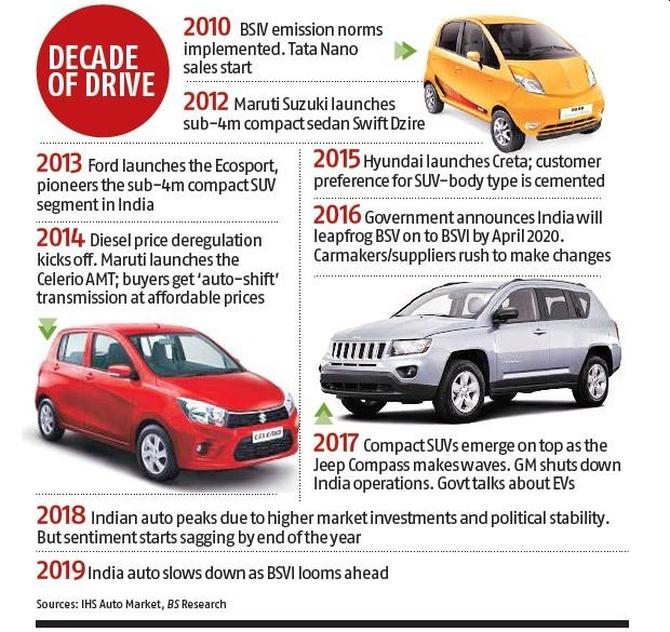 | « Back to article | Print this article |
'The future will see three impending changes: cleaner cars, connected cars and shared cars.'
Pavan Lall reports.

The past decade started on an exciting note for India's auto sector with the launch of the Nano, the world's cheapest car, by Tata Motors.
The Nano was conceived as an indigenously designed car, and though it never took off in sales and volumes, the concept was a success, which in turn spurred other automakers to re-evaluate the way they built cars.
The Renault Kwid, which has sold under 500,000 cars, and is marketed all over the world, took inspiration from the Nano, Carlos Ghosn, former chief of Nissan-Renault, had said at an international motor show.
The difference was that though the Kwid was a lower cost option, it was meant for trendy consumers in metropolitan cities across the world.
The same year saw India implement the BSIV fuel norms across 13 metro cities and the deregulation of petrol prices, which spurred a race amongst car makers for diesel-engine variants.
By 2013, Maruti Suzuki, the country's largest automaker, launched the Swift DZire. It was sub-4 metre compact sedan that subsequently expanded the segment into a much larger category, one which Honda later tapped into with its Amaze.
A more critical transition came around 2013, when two Western manufacturers launched in quick succession their renditions of the "city sport utility vehicle (SUV)".
Renault India was the first off the mark. It launched the rugged Duster that notched up strong volumes initially because of its ground-breaking design, high suspension and roomy interiors.
However, it was soon overtaken by a competitor called the Ecosport launched by Ford India, which has clocked sales of 300,000 units to date and also paved the way for a host of other brands to try their hand at the UV game.
The other big shift in the automotive sector at the time was the Uberisation of urban mobility by shared transport providers Ola and Uber, says Suraj Ghosh, IHS Markit's principal analyst of powertrain forecasts.
"It created a brand new demand space, but it also disrupted the consumer behaviour patterns for cars by rendering the concept of a four-wheeler brand-agnostic," says Ghosh.
By 2014 diesel prices were deregulated, thus signalling a gradual shift away from diesel cars. That wasn't all.
Customers now got a taste of automatic transmissions at affordable prices, thanks to the Maruti Celerio AMT, which led to others coming out with similar offerings.
As city SUVs gained in popularity, premium sedans saw their sales wane and some products even got yanked from the market altogether. These included Honda's Civic and Accord, and Volkswagen's Passat.

By 2015, Hyundai, the second largest car maker nationwide, launched its SUV Creta with a view to capturing audiences that were looking for more than what the market offered.
The gambit worked and the Creta quickly became the hot new bestseller, clocking over 200,000 units in sales.
"If you look closely, the hatch-back to sedan to SUV migration actually transpired with Tata Indigo to the Swift DZire and then to other products," said Gautam Sen, automotive author.
"It's key to note that once a market matures, the cheapest option is never the bestselling."
Meanwhile, India, which barely had a handful of auto manufacturers 20 years ago, now had almost two dozen automakers in the market.
But that didn't make for easy sales, as General Motors, one of the world's largest car makers, found out. In 2017, GM exited the country after shutting down its Chevrolet brand, which failed to make a mark even after a decade.
However, this did not deter those who saw potential in new segments. Jeep, owned by the Fiat Chrysler Alliance, launched its premium Compass SUV and saw a rush of early bookings, reaffirming that very small cars and sedans were now trends of the past.
Almost simultaneously, Mahindra & Mahindra launched its SsangYong Tivoli-derived XUV 300, Kia launched its Seltos, and Hyundai its Venue.
The common denominator in all of them was that they were styled to compete at international quality levels, priced competitively and loaded with features and technology.
If 2018 started out as a year of ebullient market sentiment, the numbers supported those dynamics and the industry saw its sales peak at over 4 million vehicles (including light commercial vehicles).
In fact, the sector attained a global ranking of 4th position, the highest ever.
But the rise was short-lived, and by 2019, production and sales had both contracted on account of the pressures of complying with BSVI, the government push for electrification and the general downturn in the economy.
"The industry witnessed an unprecedented slowdown this year," said Guenter Butschek, managing director at Tata Motors.
"It is difficult to ascertain a recovery timeline, but our focus has been on retail, leading to system stock reduction, optimising costs, and improving capital work flow," he said.
For Tata Motors, 2020 will be a make or break year. "The investments towards BSVI have been the single largest investment for Tata Motors. We are ready with our transition plan and our new BSVI products will start rolling out from January 2020," Butschek said.
As for the other dominant players, the focus seems threefold. "India is witnessing a transformation with respect to changing paradigms in the mobility space," said Hyundai India's managing director S S Kim.
"The future will see three impending changes: cleaner cars, connected cars and shared cars."
These may well be the factors driving not just Hyundai, but the entire auto industry.
Pavan Lall is a feature writer at Business Standard.